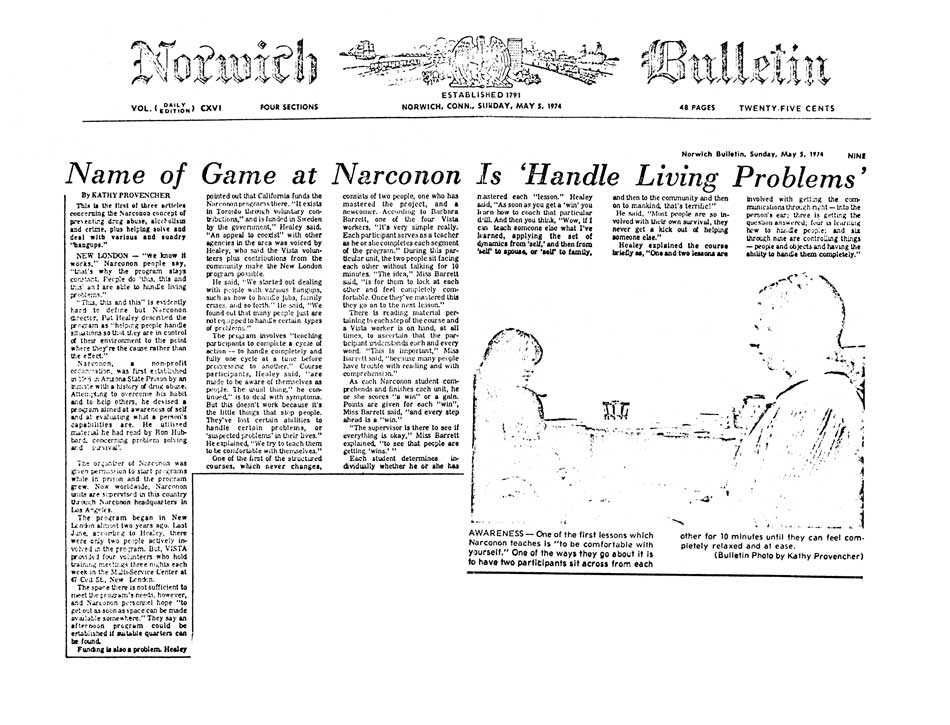1974 Article in Norwich Bulletin

Name of Game at Narconon Is ‘Handle Living Problems’
*Photo Caption:**
AWARENESS – One of the first lessons which Narconon teaches is “to be comfortable with yourself.” One of the ways they go about it is to have two participants sit across from each other for 10 minutes until they can feel completely relaxed and at ease. (Bulletin Photo by Kathy Provencher)
This is the first of three articles concerning the Narconon concept of preventing drug abuse, alcoholism and crime, plus helping solve and deal with various and sundry “hangups.”
EW LONDON - “We know it works,” Narconon people say, “that’s why the program stays constant. People do ‘this, this and this’ and are able to handle living problems.”
“This, this and this” is evidently hard to define but Narconon director, Pat Healey described the program as “helping people handle situations so that they are in control of their environment to the point where they’re the cause rather than the effect.”
Narconon, a non-profit organization, was first established in 1966 in Arizona State Prison by an inmate with a history of drug abuse. Attempting to overcome his habit and help others, he devised a program aimed at awareness of self and at evaluating what a person’s capabilities are. He utilized materials he had read by L. Ron Hubbard, concerning program solving and ‘survival’.
The organizer of Narconon was given permission to start programs while in prison and the program grew. Now worldwide, Narconon units are supervised in this country through Narconon headquarters in Los Angeles.
The program began in New London almost two years ago. Last June, according to Healey, there were only two people actively involved in the program. But, VISTA provided four volunteers who hold training meetings three nights each week in the Multi-Service Center at 47 Coit St., New London.
The space there is not sufficient to meet the program’s needs, however, and the Narconon personnel hope “to get out as soon as space can be made available somewhere.” They say an afternoon program could be established if suitable quarters can be found.
Funding is also a problem. Healey pointed out that California funds the Narconon programs there. “It exists in Toronto through voluntary contributions, and is funded in Sweden by the government,” Healey said. “An appeal to co-exist” with other agencies in the area was voiced by Healey, who said the Vista volunteers plus contributions from the community make the New London program possible.
He said, “We started out dealing with people with various hangups, such as how to handle jobs, family crises and so forth.” He said, “We found out that many people just are not equipped to handle certain types of problems.”
The program involves “teaching participants to complete a cycle of action – to handle completely and fully one cycle at a time before progressing to another.” Course participants, Healey said, “are made to be aware of themselves as people. The usual thing,” he continued, “is to deal with symptoms.
“But this doesn’t work because it’s the little things that stop people. They’ve lost certain abilities to handle certain problems, or ‘suspected problems’ in their lives.” He explained, “We try to teach them to be comfortable with themselves.”
One of the first of the structured courses, which never changes, consists of two people, one who has mastered the project, and a newcomer. According to Barbara Barrett, one of the four Vista workers, “It’s very simple really. Each participant serves as a teacher as he or she completes each segment of the program.” During this particular unit, the two people sit facing each other without talking for 10 minutes. “The idea,” Miss Barrett said, “is for them to look at each other and feel completely comfortable. Once they’ve mastered this they go on to the next lesson.”
There is reading material pertaining to each step of the course and a Vista worker is on hand, at all times, to ascertain that the participant understands each and every word. “This is important,” Miss Barrett said, “because many people have trouble with reading and with comprehension.”
As each Narconon student comprehends and finishes each unit, he or she scores “a win” or a gain. Points are given for each “win”, Miss Barrett said, “and every step ahead is a ‘win’.”
“The supervisor is there to see if everything is ok,” Miss Barrett explained, “to see that people are getting ‘wins.’”
Each student determines individually whether he or she has mastered each “lesson.” Healey said, “As soon as you get a ‘win’ you learn how to coach that particular drill. And then you think, ‘Wow, if I can teach someone else what I’ve learned, applying the set of dynamics from ‘self,’ and then from ‘self’ to spouse, or ‘self’ to family, and then to the community and then on to mankind, that’s terrific!”
He said, “Most people are so involved with their own survival, they never get a kick out of helping someone else.”
Healey explained the course briefly as, “One and two lessons are involved with getting the communications through right – into the person’s ear; three is getting the question answered; four is learning how to handle people; and six through nine are controlling things – people and objects and having the ability to handle them completely.”